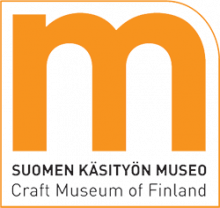Treasures of the Bazars 9.1.–18.4.2021
The Treasures of the Bazars exhibition in the Craft Museum of Finland showcases traditional textiles and jewellery from Morocco to Tibet from the collections of collector Tuomas Sopanen. Nomadism and traditions appear clearly in these consumer textiles and decorations.
Humans love beauty around them, and they strive to enhance their habitat with beautiful things, no matter what their living conditions are. What fascinates Sopanen about kilims, is found partly in enchorial ryas as well. They have been mainly utility articles, just like Finnish ryas. “The beauty of kilims proves that humans have a very deep longing for beauty and understanding as well as a desire to create something beautiful for their habitat. They are willing to work hard to achieve this,” says Sopanen who gathered the collection. Even the nomads, known for their mobile lifestyle, strived to create cosiness and beauty around them with methods suitable for that. Moving long distances with herds of animals impacted greatly what could be carried along. The nomad women developed a thin, versatile, and pile-free type of rug, kilim, without scaling down on beauty, because kilims delight with their bright colours and motifs.
Textiles have been and are made with the same technique almost all across the world, but the word kilim is used for mainly fuzz-free rugs and rug-like textiles made in the Islamic culture’s area of influence. Kilims have been woven especially in Turkey, Iran, countries in the Caucasus region but also in Central Asia, as well as North African Arab countries, especially in Morocco and Tunisia. Kilims have been woven in Romania as well, but they differ quite a bit from the others.
Weaving kilims does not proceed row by row like traditional rug weaving, a motif can be woven for several rows with the same colour by threading the yarn back and forth from one side of the motif to the other. The weft yarn is battened tightly, with a tool that resembles a large fork, into the relatively sparse warp yarn which cannot therefore be seen and that lets the colours in the motifs shine. The kilims created with the basic technique look the same on both sides. The purpose of kilims is variable and often even textiles designed for other purposes, like bags, horse blankets and storage sacks, made with a similar technique are considered kilims.
The motifs in kilims vary regionally and between tribes. Each tribe had a basic motif that was typical to them, but each weaver changed it in their own way which makes finding two identical nomad kilims very unlikely. When a kilim covered a load carried by a camel, it was easy to recognise the tribe of the wayfarers from far away. The motifs in kilims are geometrical and often derived from triangles, like hexagons and 8-pointed stars. Many of the motifs are symbols that are meant to protect the user from danger, the evil eye or bring them happiness, success, harmony in marriage or many children. Prayer kilims are particularly beautiful. The exhibition has kilims from a vast area, from Tibet to Morocco so it is easy to immerse yourself in the differences of various areas.
A part of Sopanen’s collection is also a significant amount of jewellery from the nomad regions. These magnificent silver jewellery with their amazing details can also be admired in the Treasures of the Bazars exhibition. The special characteristics of tribes and areas can clearly be seen in the traditional nomad jewellery as well, just like in kilims or Finnish ryas and national costumes. Together with the kilim rugs, they give a wonderful insight into the nomad cultures from Morocco to Tibet.
Collector Tuomas Sopanen and kilims
Tuomas Sopanen is one of the biggest collectors in Finland and his collection consists of a myriad of ryas and works of Dora Jung. Sopanen’s interest in kilims got its start already in his childhood home where they had, now over a 100-year-old, colourful rug on the floor, that intrigued little Sopanen with its colourfulness. “Otherwise, we didn’t have strong colours in our interior decorating, and I have always enjoyed colours. I believe that childhood influences burrow deep in the nook of our minds and effect the things we like”, Sopanen believes.
Sopanen purchased his own first kilim from London in the year 1979 when he was there to write his doctoral dissertation. Simple in motifs but pleasant in colours, the rug was in everyday use on the floor of Sopanen’s home. It is sometimes difficult to find old kilims because often Sopanen is offered only new kilims. This is what happened in the Great Bazaar of Istanbul in the 80s, when Sopanen found the second kilim to his collection after a long search.
“I had to search for a long time before one shopkeeper took me to his friend’s shop where I finally found one that was how it was supposed to be.” The prayer kilim in question, that has a tree of life motif on it, can also be seen in the Treasures of the Bazars exhibition.
Nowadays Sopanen’s collection consists of 96 kilims or other weaves created with the same technique.
Treasures of the Bazars
Exhibition in the Craft Museum of Finland 9.1.–18.4.2021
Exhibition catalogue - English (pdf, 3Mb)
More information
Mikko Oikari, senior curator, Craft Museum of Finland
tel. +358 50 553 3880, mikko.oikari [a] jyvaskyla.fi

